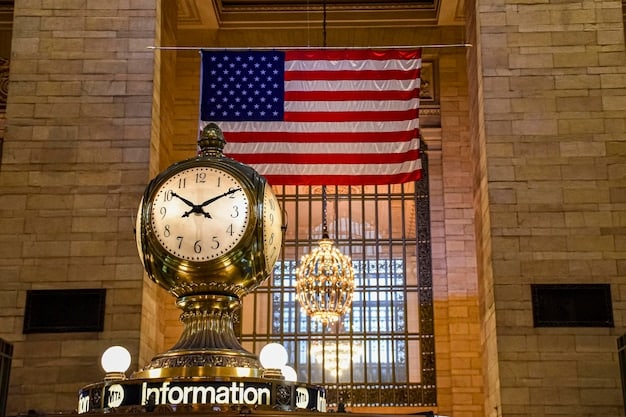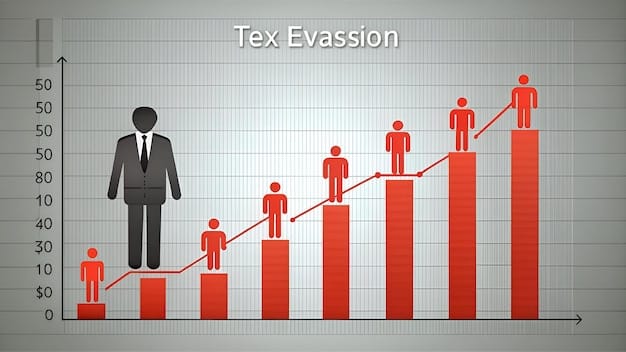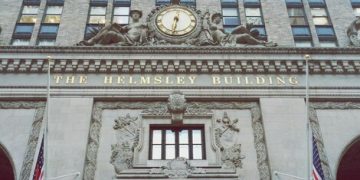Federal Reserve Holds Rates Steady: What It Means for You

The Federal Reserve has maintained interest rates for the third consecutive month, signaling a wait-and-see approach amidst cooling inflation and a resilient labor market, directly impacting borrowing costs, investment decisions, and the overall economic outlook for businesses and consumers in the United States.
The financial world is abuzz with the latest decision from the Federal Reserve. For the third consecutive month, the Federal Reserve has held interest rates steady. This move, a direct response to a complex economic landscape, carries significant implications for everyone, from large corporations to individual consumers. Understanding the rationale behind this decision and its potential ripple effects is crucial in navigating the current economic climate.
Understanding the Fed’s Decision to Hold Rates
The Federal Reserve’s decision to maintain the federal funds rate at its current level for the third month is a pivotal moment in monetary policy. This move reflects a cautious approach, as policymakers evaluate the cumulative impact of past rate hikes on inflation and economic growth. It suggests that the Fed believes its previous actions are working, and the economy is on a path toward stable prices without necessarily triggering a severe downturn.
At its core, the Federal Reserve’s mandate involves promoting maximum employment and stable prices. When inflation rises too quickly, the Fed typically raises interest rates to cool down the economy by making borrowing more expensive, thereby reducing demand. Conversely, when inflation is too low or unemployment is high, the Fed might lower rates to stimulate economic activity.
Key Factors Influencing the Decision
Several critical economic indicators informed the Fed’s latest decision. These metrics provide a comprehensive picture of the economy’s health and offer insights into potential future actions. Understanding these factors is essential for grasping the nuances of monetary policy.
- Wage Growth: While still elevated, there are signs that wage growth is moderating, easing some inflationary pressures from the labor market.
- Consumer Spending: Despite higher borrowing costs, consumer spending has remained resilient, supported by a strong job market and accumulated savings.
- Geopolitical Events: Global uncertainties continue to influence commodity prices and supply chains, presenting a potential upside risk to inflation.
The most recent inflation reports have shown a consistent moderation, albeit at a slower pace than some would prefer. The Consumer Price Index (CPI) and Personal Consumption Expenditures (PCE) index, the Fed’s preferred inflation gauge, have both indicated a gradual cooling. This deceleration in price increases has given the Fed room to pause, allowing its past rate hikes to fully transmit through the economy before making further adjustments.
Furthermore, the labor market, while showing signs of normalizing, remains remarkably robust. Unemployment rates are historically low, and job growth, though slowing, continues to be positive. This strength in the employment sector provides a buffer against economic shocks and supports consumer confidence, even as other sectors might feel the pinch of higher rates.
The Fed’s communication surrounding this decision emphasized a “data-dependent” approach, meaning future policy moves will hinge directly on how economic data evolves. This flexibility allows the central bank to respond effectively to new information, whether it points to persistent inflation or an unexpected slowdown in growth. This cautious stance aims to avoid over-tightening, which could push the economy into a recession, or under-tightening, which could allow inflation to re-accelerate.
Market Reactions and Investor Sentiment
The financial markets, always sensitive to Federal Reserve announcements, reacted with a mixture of relief and anticipation to the decision to hold interest rates steady. Investors had largely priced in this outcome, but the accompanying statements and future guidance provided crucial context that shaped market sentiment in the immediate aftermath.
Equity markets generally saw a positive response, with major indices showing modest gains. The absence of a rate hike was interpreted as a sign that the Fed is confident in the current trajectory of disinflation without needing to impose further brakes on economic activity. This suggests a perceived reduced risk of a hard landing, where aggressive monetary tightening precipitates a recession, which is often a significant concern for stock market participants.
Bond Market Dynamics
In the bond market, yields experienced some fluctuations but largely remained stable. The yield on the 10-year Treasury note, a benchmark for various lending rates, adjusted slightly as market participants digested the Fed’s forward guidance. A steady rate environment can be beneficial for fixed-income investors, as it provides a clearer picture of future returns and reduces volatility.
- Reduced Volatility: Stability in benchmark rates can lead to less uncertainty in bond prices, offering a more predictable environment for investors.
- Attractive Yields: Current yield levels remain relatively high compared to recent history, presenting opportunities for income-focused investors.
- Economic Outlook: Bond market reactions often reflect broader expectations about economic growth and inflation, hinting at a more balanced outlook.
The dollar’s performance also garnered attention. Typically, a pause in rate hikes could weaken a currency as the interest rate differential narrows compared to other nations still tightening their policies. However, the dollar demonstrated resilience, supported by the perception of the U.S. economy’s relative strength and continued demand for safe haven assets amid global uncertainties.
Investor sentiment, while generally positive due to the pause, remains cautious. Many are now focused on the timeline for potential future rate cuts, with differing views on when and how aggressively the Fed might begin to ease policy. The Fed’s own “dot plot”—a projection of future interest rates by individual FOMC members—will be closely scrutinized for any shifts in expectations, indicating the path forward for monetary policy and its impact on asset valuations.

Impact on Businesses and Consumers
The Federal Reserve’s decision to hold interest rates steady has profound implications that ripple through both the business landscape and the daily lives of consumers. For companies, this pause offers a moment of stability amidst fluctuating economic conditions, potentially influencing investment and expansion plans. For individuals, it impacts everything from mortgage rates to savings accounts, shaping financial decisions in a tangible way.
For businesses, the stability in interest rates can be a double-edged sword. On one hand, the cost of borrowing remains elevated compared to pre-tightening periods, which can still deter new capital expenditures or slow down expansion plans that rely on debt financing. Small and medium-sized enterprises (SMEs) are often more sensitive to these borrowing costs, potentially facing tighter credit conditions from banks.
Consumer Finances and Borrowing
Consumers directly feel the effects of interest rate decisions through various financial products. Mortgage rates, though they don’t directly track the federal funds rate, are influenced by broader bond market yields, which in turn react to Fed policy. A stable federal funds rate can lead to relative calm in mortgage rates, offering a window of predictability for homebuyers and those looking to refinance.
- Mortgage Costs: While not directly tied, stability in the federal funds rate can help temper volatility in mortgage rates, offering some predictability for homebuyers.
- Credit Card Interest: Rates on credit cards and other variable-rate loans are often directly pegged to the prime rate, which moves in tandem with the federal funds rate, meaning these costs remain high.
- Savings Returns: Higher interest rates generally translate to better returns on savings accounts, CDs, and money market funds, benefiting those with cash reserves.
Conversely, for those with existing variable-rate debt, such as certain types of credit cards or adjustable-rate mortgages, the continued high rates mean that their monthly payments will remain elevated. This sustained pressure on household budgets can dampen discretionary spending, despite a strong labor market. However, savers benefit from this environment, as interest-bearing accounts continue to offer more attractive returns than in the near-zero rate era.
From a broader economic perspective, the pause aims to allow the economy to absorb the previous rate hikes without tipping into a recession. This delicate balancing act seeks to bring inflation down to the Fed’s 2% target while preserving as much employment and economic growth as possible. Both businesses and consumers will continue to monitor future Fed communications closely, as any hint of further tightening or easing will undoubtedly influence their financial strategies and confidence.
The Road Ahead: Future Possibilities and Challenges
Looking forward, the Federal Reserve faces a complex set of choices, balancing the need to control inflation with the desire to maintain economic stability. The current pause in interest rate hikes offers a moment for reflection, but it doesn’t signify the end of policy adjustments. Rather, it marks a pivot towards a data-dependent strategy, where every economic report will be scrutinized for clues about the next move.
One of the primary challenges ahead is the persistence of inflation in certain sectors. While headline inflation has been moderating, core inflation—which excludes volatile food and energy prices—has proven stickier. This suggests that underlying demand pressures or structural economic factors might still be at play, making the final stretch back to the 2% target potentially difficult.
Potential Scenarios for Monetary Policy
The Fed’s future actions could unfold in several ways, each with distinct implications for the economy. Policymakers are constantly evaluating the incoming data to determine the most appropriate course of action, aiming for a soft landing while avoiding a resurgence of inflationary pressures.
- Further Rate Hikes: If inflation proves more persistent than expected or the economy shows unexpected strength, the Fed could resume tightening.
- Extended Pause: The Fed might opt for a prolonged period of steady rates, allowing more time for the previous hikes to fully impact the economy.
- Rate Cuts: If economic growth slows significantly or inflation falls rapidly below target, the Fed could begin to cut rates to stimulate activity.
Another significant consideration is the state of the global economy. Geopolitical tensions, shifts in international trade, and economic conditions in major trading partners can all influence U.S. economic performance and inflation. The Fed must factor these external dynamics into its decision-making, complicating an already intricate domestic picture.
Moreover, the concept of a “higher for longer” interest rate environment is gaining traction among analysts. This implies that even if the Fed avoids further hikes, rates may remain elevated for an extended period, rather than quickly reverting to the near-zero levels seen previously. This scenario has long-term implications for corporate debt, government borrowing, and the cost of capital across the economy, potentially reshaping investment strategies and growth trajectories for years to come.
The Role of the Federal Reserve: Beyond Rates
While interest rate decisions capture the most headlines, the Federal Reserve’s influence extends far beyond the federal funds rate. As the central bank of the United States, its mandate encompasses a broad range of responsibilities that are critical for maintaining the stability and integrity of the nation’s financial system. Understanding these multifaceted roles provides a more complete picture of the Fed’s importance.
One of the Fed’s primary functions is to supervise and regulate banks and other financial institutions. This involves setting capital requirements, conducting stress tests, and monitoring risk management practices to ensure that banks remain sound and capable of withstanding economic shocks. This oversight is crucial for preventing financial crises and protecting depositors and the broader economy.
Maintaining Financial Stability
A stable financial system is the bedrock of a healthy economy. The Federal Reserve plays a crucial role in responding to financial upheavals, acting as a lender of last resort to banks facing liquidity shortages, and working to mitigate systemic risks that could undermine confidence in the financial markets.
- Systemic Risk Oversight: Identifying and addressing risks across the financial system to prevent widespread instability.
- Payment Systems: Operating and overseeing the nation’s payment systems, such as Fedwire and ACH, ensuring efficient and secure transactions.
- Consumer Protection: Enforcing consumer protection laws related to banking and financial products, ensuring fair and transparent practices.
Beyond regulation, the Fed is also responsible for promoting the safety and efficiency of the payment system. This involves operating critical infrastructure, such as the Fedwire Funds Service and the automated clearinghouse (ACH) network, which facilitates trillions of dollars in daily transactions. Ensuring these systems are robust and secure is vital for the smooth functioning of commerce.
Furthermore, the Federal Reserve conducts extensive research and analysis on economic and financial issues. This intellectual capital informs policy decisions, contributes to public understanding of the economy, and helps shape the debate on critical economic challenges. Through publications, speeches, and public outreach, the Fed strives to be a transparent and authoritative source of economic information, reinforcing its credibility and guiding market expectations.

Historical Context of Fed Rate Decisions
To fully appreciate the significance of the Federal Reserve’s current decision, it’s beneficial to look at its actions through a historical lens. The Fed’s approach to monetary policy has evolved significantly over time, shaped by economic crises, inflation scares, and shifts in economic theory. Understanding this history provides context for the choices made today and highlights the lessons learned from past cycles.
In the 1970s, the U.S. experienced a period of “stagflation” – high inflation coupled with stagnant economic growth. The Fed, under Chairman Paul Volcker, responded with aggressive interest rate hikes in the early 1980s, which, while painful in the short term, ultimately broke the back of inflation. This period cemented the Fed’s commitment to price stability as a paramount objective.
Evolution of Monetary Policy Tools
Over the decades, the Federal Reserve has refined its toolkit for managing the economy. While the federal funds rate remains the primary lever, other instruments have gained prominence, particularly in response to more recent crises. These tools allow the Fed to address a wider range of economic and financial challenges.
- Quantitative Easing (QE): Implemented during the 2008 financial crisis and the COVID-19 pandemic, QE involves large-scale asset purchases to lower long-term interest rates and inject liquidity.
- Forward Guidance: The Fed uses communication about its future policy intentions to influence market expectations, providing clarity and reducing uncertainty.
- Discount Window: A standing facility that allows banks to borrow from the Fed at the discount rate to meet short-term liquidity needs.
The 2008 global financial crisis marked another turning point. With interest rates already near zero, the Fed introduced unconventional monetary policies, such as quantitative easing (QE), to provide further stimulus. This period demonstrated the Fed’s willingness to innovate and expand its role in times of extreme economic distress, moving beyond traditional rate adjustments.
More recently, the COVID-19 pandemic triggered an unprecedented response, with rapid rate cuts and massive asset purchases to support the economy. The subsequent surge in inflation, driven by supply chain disruptions and strong demand, forced the Fed into its most aggressive tightening cycle in decades, leading to the current pause. This historical progression illustrates the dynamic nature of monetary policy, constantly adapting to new economic realities while adhering to its core mandates.
Global Economic Implications of the Fed’s Stance
The Federal Reserve’s monetary policy decisions resonate far beyond the borders of the United States, significantly influencing the global economy. As the world’s largest economy and holder of the primary reserve currency, the U.S. Fed’s actions can impact everything from exchange rates and commodity prices to capital flows and the monetary policies of other central banks.
When the Fed tightens monetary policy, by raising interest rates, it typically strengthens the U.S. dollar. A stronger dollar makes U.S. exports more expensive and imports cheaper. For countries that import heavily from the U.S. or have dollar-denominated debt, a strengthening dollar can increase their financial burden, potentially leading to capital outflows from emerging markets as investors seek higher returns in dollar-denominated assets.
Impact on International Trade and Currencies
The interplay between Fed policy and global economic conditions is complex, leading to various knock-on effects across international markets. Understanding these connections is crucial for businesses operating globally and for policymakers in other nations who must adapt their strategies accordingly.
- Exchange Rate Volatility: Changes in the U.S. federal funds rate can cause significant fluctuations in currency markets, affecting the cost of trade and investment.
- Commodity Prices: A stronger dollar often puts downward pressure on commodity prices, as many are priced in dollars, impacting commodity-exporting nations.
- Emerging Markets: Higher U.S. rates can lead to capital flight from emerging economies, making it harder for them to finance their debts and potentially inducing currency crises.
Conversely, a pause in rate hikes, as seen currently, or a potential easing of policy in the future, can alleviate some of these pressures. While the dollar may not weaken dramatically, the absence of further tightening reduces the incentive for capital to flow out of other markets, providing some breathing room for international economies, particularly those with high levels of dollar-denominated debt.
Many central banks around the world often find themselves in a challenging position, having to respond to the Fed’s decisions to manage their own currencies and inflation rates. For instance, if the Fed maintains high rates, other central banks may feel compelled to keep their rates elevated as well to prevent their currencies from depreciating too much against the dollar, which would fuel imported inflation. This interconnectedness underscores the profound global implications of every Federal Reserve announcement.
| Key Point | Brief Description |
|---|---|
| 📊 Steady Rates | The Federal Reserve held interest rates steady for the third consecutive month. |
| 📈 Economic Data | Decision based on cooling inflation and resilient labor market data. |
| 💼 Consumer Impact | Affects borrowing costs, mortgage rates, and savings returns. |
| 🌍 Global Effect | Influences exchange rates, capital flows, and other central banks’ policies. |
Frequently Asked Questions About Fed Rate Holds
When the Federal Reserve holds interest rates steady, it means they are not raising or lowering the federal funds rate. This indicates that policymakers believe the current monetary policy settings are appropriate for achieving their economic goals of price stability and maximum employment, often signaling a period of evaluation of past tightening measures.
For borrowers, a steady interest rate means that the cost of new loans and variable-rate debt, such as certain credit cards or adjustable-rate mortgages, will likely remain at their current levels. While borrowing costs are not decreasing, the stability can provide some predictability compared to periods of frequent rate hikes, allowing for better financial planning.
Savers typically benefit from steady, elevated interest rates. Returns on savings accounts, certificates of deposit (CDs), and money market funds will likely remain attractive. This encourages saving as the yield on deposits stays competitive, providing a continuous income stream for those with cash reserves, even without further increases.
The Federal Reserve decided to pause rate hikes primarily due to signs of cooling inflation and a resilient, but normalizing, labor market. Policymakers aim to assess the full impact of their previous aggressive tightening measures on the economy, seeking to achieve their 2% inflation target without triggering an unnecessary recession, by adopting a data-dependent strategy.
After a rate hold, the Fed’s future actions largely depend on incoming economic data. Potential scenarios include resuming rate hikes if inflation re-accelerates, extending the pause for a longer period to observe economic trends, or initiating rate cuts if economic growth significantly slows or inflation falls consistently below target. The Fed remains highly flexible.
Conclusion
The Federal Reserve’s decision to hold interest rates steady for the third consecutive month marks a significant, yet nuanced, chapter in its monetary policy saga. It signals a careful balancing act: a belief that previous aggressive hikes have begun to tame inflation, coupled with a cautious stance to avoid over-tightening during a period of economic resilience. For businesses and consumers alike, this pause offers a measure of stability, but also underscores the “higher for longer” narrative, keeping borrowing costs elevated while rewarding savers. As global financial markets react and adapt, all eyes remain firmly fixed on incoming economic data and the Fed’s continued commitment to navigating the complex path toward sustained price stability and maximum employment without derailing economic growth.





